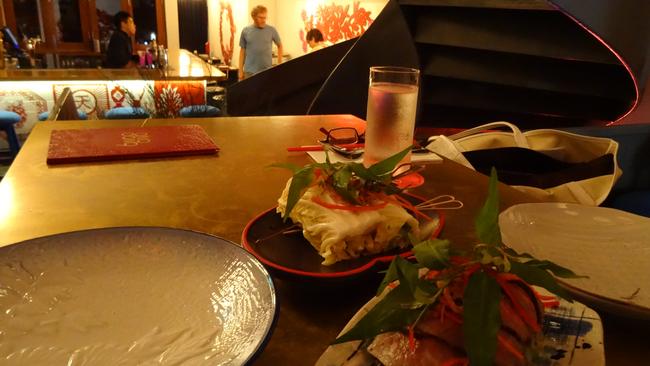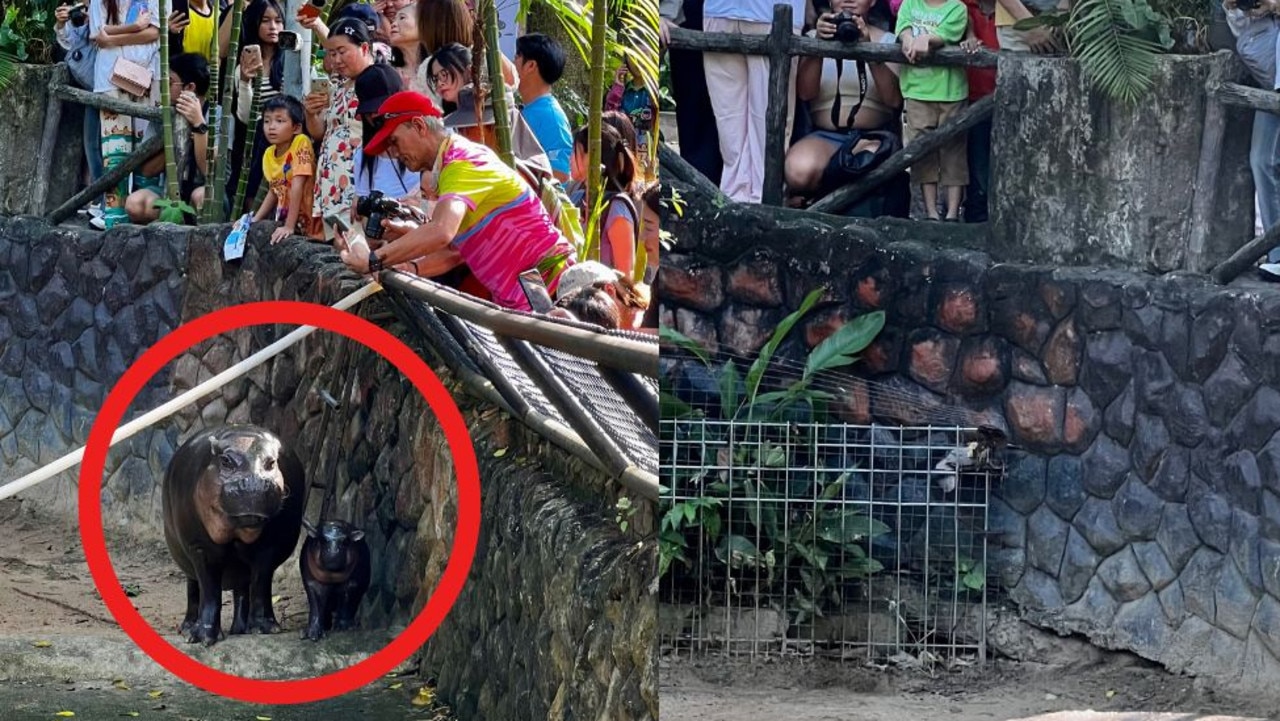Explore the strange side of Singapore
SINGAPORE can be fun, kooky and weird — and it’s not just because you need a prescription to get chewing gum.

WHILE many people think of Singapore as a highly conventional city that has way too many shopping centres, there is more to this law-abiding country than the fact you need a prescription to buy chewing gum.
What most people don’t get to see is the hip side of this diverse city-state, which makes it fun to explore and a bona fide foodie heaven. In particular, those who visit the areas around Chinatown and the Arab Quarter, will be rewarded with quirky bars, indie clothing boutiques and unique dining experiences often set in picturesque colonial-style buildings. Despite being a highly urbanised place, Singapore also prides itself on being a garden state and wears its environmental heart on its sleeve — not something you would expect in a place known for its 24-hour shopping malls. This year Singapore was also named the hottest travel destination in the world for 2015 by travel publisher Lonely Planet, partly in recognition of its emerging fashion and cafe scene, but also because it celebrates its Golden Jubilee this year and will open a number of new attractions including the National Art Gallery. Its diversity is one of the city’s most interesting features and residents enjoy a smorgasbord of public holidays for Christmas, Easter, Deepavali, Buddhist holiday Vesak Day, the Muslim holidays Hari Raya Haji and Hari Raya Puasa, as well as Chinese New Year, New Year’s Day, National Day and Labour Day. My tour guide is typical of this cultural mixed bag. She was born in Singapore, married to a Dutch man, and spoke Malay, Tamil, French and English. She says the wide variety of public holidays promotes goodwill among the multicultural population, because even if you aren’t Chinese, Buddhist, Indian, Christian, or Muslim, everybody enjoys a three-day weekend right? Those who do celebrate a particular festival are called on to host parties so others can take part in the traditions. It seems like a lovely way to promote harmony between all residents. Residents are also very proud of Singapore’s unique traditions, many of which revolve around food. One popular bookshop featured little zines dedicated to national dishes such as chicken rice, or salted vegetables and duck shop. This is a place where nostalgia for certain foods or institutions, such as the traditional wet markets or Singapore’s public housing estates, is being embraced and reinvented by the country’s young hipsters. MARKETS AND SHOPPING HDB buildings are an institution in Singapore. These public housing estates began to be built in the 1930s and unlike the Australian version, there is no stigma associated in living in these blocks. Many of the oldest ones were built in the 1960s and 1970s, to provide affordable accommodation for locals, and are now considered very valuable. About 85 per cent of the population live in these government-built homes, which residents are allowed to buy and sell. Tiong Bahru was Singapore’s first housing estate and was built in the 1930s. Like many HDB flats, facilities like a wet market and hawker centre were developed there to house vendors who used to sell their wares in the street. Nowadays it is one of the only places where there is still a functioning market, as they are slowly dying due to the population embracing 24-hour malls and supermarkets. The hawker centre, which is Singapore’s version of a food court, is famous for its local breakfast dishes and Singaporeans travel from all over the island to eat there. Downstairs is what is called a “wet market” where you can buy fresh fruit, veges, meat and seafood. One nice thing to do if you have a tub where you are staying, is to pick up some fresh jasmine flowers from a market flower vendors, as they add a lovely scent to your bath. The hawker centre offers traditional breakfast dishes such as the kaya toast (toast served with coconut jam), chwee kueh (steamed rice cakes topped with chilli sambal), nasi lemak (rice cooked in coconut milk and served with fried egg, chicken wing, anchovies and chilli paste) and lontong (steamed rice cakes in a spicy coconut curry gravy). The area around the market is also worth exploring for its retro buildings, and some interesting shops including an organic Asian goods store (Yes Natural, opposite Tiong Bahru market). It’s definitely worth heading there if you want to stock up on unusual groceries such as handmade brown rice egg rolls and a wide range of noodles including organic brown rice vermicelli. Across the Singapore River is Kampong Glam, home to the Arab quarter but also Haji Lane, where you are guaranteed to spot some hipsters/bloggers taking photos along its colourful streetfront. This is where you will find affordable indie boutiques, cafes, bike shops, cute little bakeries and bars. There’s more local shopping at Yong Siak Street, which is home to an independent bookshop of local and obscure authors, Books Actually, where you can find zines and other books celebrating Singapore’s underground culture. GARDEN CITY Singapore may be a highly urbanised country but it takes pride in being a garden city, and it is an offence to chop down a tree with a trunk with a circumference of more than 1 metre. One company, Debenham Tie Leung was forced to pay more than $80,000 for removing one tree thought to be more than 100 years old and the last of its kind in the country. If you are feeling energetic, you can take a walk in the hilly Southern Ridges, a 10km span of green, open spaces overlooking the city. Singapore is known for its humidity so you will work up a sweat. You’ll be joined by elderly locals getting their daily exercise and teenagers relaxing in one of the shaded alcoves of the undulating Henderson Waves Bridge, described as one of the 18 strangest bridges in the world by Popular Mechanics. GARDENS BY THE BAY But if you prefer air-conditioned comfort you can visit a huge glass conservatory at Gardens By The Bay, which is in the area next to the famed Marina Bay Sands hotel. The complex includes the Flower Dome, where you can see plants from all around the world including giant cactus, and the Cloud Forest, an artificial mountain environment which includes a fake waterfall. From here you also get a view of Singapore’s towering man-made Supertrees, which from a distance looked like they were part of a weird post-apocalyptic landscape. Some of these huge fake trees lined with vertical gardens have been fitted with solar panels to generate electricity for the Cloud Forest and Flower Dome. By day they also provide shade for pedestrians and at night there is a dramatic light show complete with a soaring cinematic score. It’s a very popular feature with hundreds grabbing a seat under one of the “Supertrees” or lying back on the ground to watch the free presentation. You can also enjoy the sunset from one of the aerial ramps linking the trees, or grab a drink at the IndoChine bar located at the top of a Supertree. It’s a good idea to book, especially if you want to enjoy dinner later at the restaurant. Up to two thirds of Singapore’s land area consists of water catchment and if you want to check out the country’s more rustic side you can take a bum boat to Pulau Ubin. The diesel fumes from the rickety boats and mangroves don’t make for the most fragrant experience but it is fun riding bikes around the island. MAKING MERRY Singapore is rightly famous for its Chilli Crab (which is a must-do and great value), but there are also plenty of places where you can enjoy more a modern take on traditional flavours. Keong Saik Rd and Ann Siang Rd near Chinatown are both filled with restaurants and bars doing interesting things. While alcohol is expensive (over $10 for a glass of wine and about $20 for cocktails), food is within the same price range as Australia ($10 or under for dishes at hawker stalls). Try the crab if you can, it’s one dish that’s substantially cheaper (we got two decent sized crabs for about $150) and also delicious. Many food places are run by expats and you can sample dishes from the likes of Ryan Clift, former head chef of iconic Melbourne venue Vue de Monde. Clift now runs Ding Dong, where the menu includes crispy pork ear with Sichuan pepper and lime ($13), Vietnamese Scotch eggs ($15) or scallop ceviche with fresh coconut and Chinese cabbage ($17). Bincho is another gem located near Tiong Bahru. This quirky yakitori-style restaurant and cocktail bar is located at the back of a traditional mee pok noodle shop. If you make your way through the noodle shop (called Hua Bee), there is a set of Japanese curtains, behind which is a cosy dining area and counter where people can watch the chefs at work. It offers great value at lunchtime when you chose from a handful of set menus ranging in price from $18 to $37. This includes five courses and rice tea. The exquisite presentation, trendy surroundings and delicate flavours make this place a cool place to visit. FUN FACTS • You are not allowed to bring chewing gum into Singapore and you can’t buy it there unless you have a prescription if you need it for therapeutic purposes (like strengthening tooth enamel) • It is illegal to wander naked at home, outside of your bathroom, and you can be fined up to $2000 or sent to jail for three months if you expose yourself to public view in a private place. • A favourite Malay proverb “bagaikan kacang lupakan kulit”, translates to “like a peanut forgetting its shell”, and is used to describe a person who forgets/denies his roots. RECOMMENDED • Explore Tiong Bahru and Yong Siak St, home to Books Actually • Affordable, designer and quirky shopping at Haji Lane at Kampong Glam • For a boutique hotel experience near Chinatown, stay at New Majestic Hotel • Lunch at yakitori style restaurant Bincho is good value, but it’s also open for dinner and drinks • If you are in Dempsey Hill, go for elegant cafe lunch at PS Cafe or enjoy the famous Singapore Chilli Crab at Long Beach Seafood Restaurant • For dinner and drinks go to Ann Siang Rd or Keong Saik Rd • Supertree light show at Gardens by the Bay, is on every night at 7.45pm • Find a rooftop bar for sunset drink, the view from Marina Bay Sands is the most famous • It’s a bit touristy but Boon Tat St, Singapore’s famous “satay street” is worth a visit. You don’t have to purchase food from the outdoor stalls to sit at the tables • Enjoy a boat ride and biking around Pulau Ubin island • If you have kids visit River Safari, to see lots of fish and wildlife including pandas Charis Chang travelled as a guest of the Singapore Tourism Board. More photos on Facebook, or Instagram @CharisChang2 All prices have been converted to Australian dollars.




